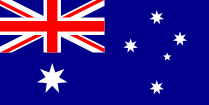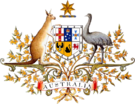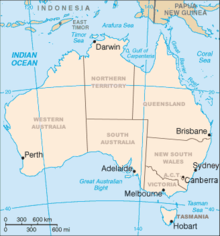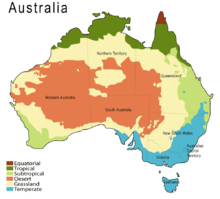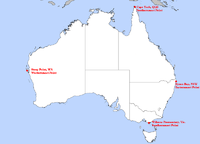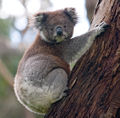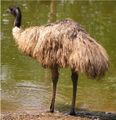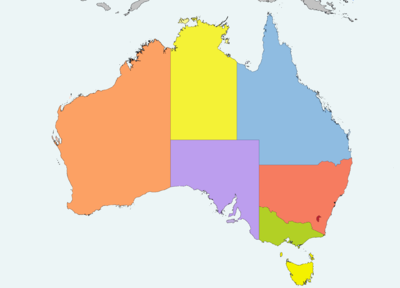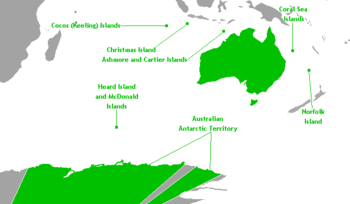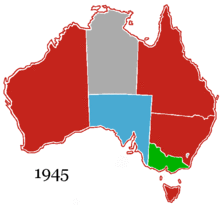- Outline of Australia
-
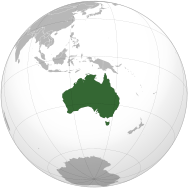 Location of Australia
Location of Australia
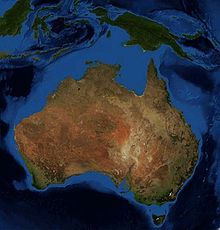 Continent of Australia showing the continental shelf (light blue) around the mainland extending to the islands of New Guinea and Tasmania
Continent of Australia showing the continental shelf (light blue) around the mainland extending to the islands of New Guinea and Tasmania See also: Index of Australia-related articles
See also: Index of Australia-related articlesThe following outline is provided as an overview of and topical guide to Australia:
Australia refers to both the continent of Australia and to the Commonwealth of Australia, the sovereign country. Australia, the world's smallest continent, is in the southern hemisphere and borders both the Indian Ocean and the Pacific Ocean.
The Commonwealth of Australia comprises the mainland of the Australian continent, plus the major island of Tasmania, and other nearby islands.[1] The neighbouring countries are Indonesia, East Timor, and Papua New Guinea to the north, the Solomon Islands, Vanuatu, and New Caledonia to the north-east, and New Zealand to the south-east.
The Australian mainland has been inhabited for more than 42,000 years by Indigenous Australians.[2] After sporadic visits by fishermen from the north and then European discovery by Dutch explorers in 1606,[3] the eastern half of Australia was later claimed by the British in 1770 and initially settled through penal transportation as part of the colony of New South Wales, commencing on 26 January 1788. As the population grew and new areas were explored, another five largely self-governing Crown Colonies were established during the 19th century.
Contents
General reference
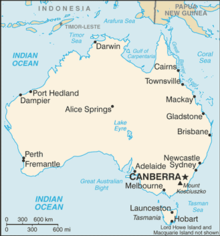 An enlargeable basic map of Australia
An enlargeable basic map of Australia
- Pronunciation:
- Australian English: IPA: [əˈstræɪljə], [əˈstræɪliː.ə], [əˈstræɪjə]
- British English: IPA: [ɒˈstreɪlɪ.ə], [ɒˈstreɪlijə]
- American English: [ɑˈstreɪli.ə], [ɑˈstreɪljə] (
 listen)
listen)
- Common English country name: Australia
- Official English country name: The Commonwealth of Australia
- Common endonym(s):
- Official endonym(s):
- Adjectival(s): Australian
- Demonym(s):
- Etymology: Name of Australia
- International rankings of Australia
- ISO country codes: AU, AUS, 036
- ISO region codes: See ISO 3166-2:AU
- Internet country code top-level domain: .au
Geography
 An enlargeable topographic map of Australia
An enlargeable topographic map of Australia
- Main articles: Australia (continent), Australia, and Geography of Australia
- Australia is...
- Location:
- Australia is a region or subregion of:
- Australia lies between:
- Indian Ocean
- Pacific Ocean
- South Pacific Ocean
- Southern Ocean by some reckonings
- Time zones:
- Extreme points of Australia (mainland)
- Northernmost Point – Cape York, Queensland (10°41' S)
- Southernmost Point – South Point, Wilsons Promontory, Victoria (39°08' S)
- Westernmost Point – Steep Point, Western Australia (113°09' E)
- Easternmost Point – Cape Byron, New South Wales (153°38' E)
- Highest Point – Mount Kosciuszko 2,228 m (7,310 ft)
- Lowest Point – Lake Eyre −15 m (−49 ft)
- Land boundaries: none
- Coastline: 25,760 km
- Population of Australia: 22,065,700 people [4] (September 2009) – 53rd most populous country
- Area of Australia: 7,741,220 km2 (2,988,900 sq mi) – 6th largest country
- Atlas of Australia
Environment
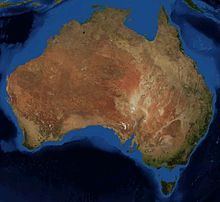 An enlargeable satellite image of Australia
An enlargeable satellite image of Australia Main article: Environment of Australia
Main article: Environment of Australia- Climate of Australia
- Bushfires in Australia
- Climate change in Australia
- Effects of global warming on Australia
- Ecoregions of Australia
- Environmental issues in Australia
- Renewable energy in Australia
- Geothermal power in Australia
- Solar power in Australia
- Wind power in Australia
- Geology of Australia
- National parks of Australia
- Protected areas of Australia
- Wildlife of Australia
- Flora of Australia
- Fauna of Australia
- Birds of Australia
- Mammals of Australia
- Iconic wildlife of Australia
-
A koala.
-
A kangaroo.
-
The Saltwater Crocodile is the largest species of crocodile in the world.
-
An emu.
Geographic features
See also: Category:Landforms of Australia- Islands of Australia
- Lakes of Australia
- Mountains of Australia
- Rivers of Australia
- Valleys of Australia
- Waterfalls of Australia
- World Heritage Sites in Australia
Regions
Main article: Regions of AustraliaMulti-state regions
- Barkly Tableland
- Capital Country
- Eastern states of Australia
- East Coast of Australia
- Lake Eyre Basin
- Murray-Darling Basin
- Northern Australia
- The Nullarbor
- Outback
- Southern Australia
Administrative divisions
Main article: States and territories of AustraliaStates
Territories
Mainland territories
External territories
 Ashmore and Cartier Islands
Ashmore and Cartier Islands Australian Antarctic Territory
Australian Antarctic Territory Norfolk Island
Norfolk Island Christmas Island
Christmas Island Cocos (Keeling) Islands
Cocos (Keeling) Islands Coral Sea Islands Territory
Coral Sea Islands Territory Heard and McDonald Islands
Heard and McDonald Islands
Municipalities
Main article: Local Government Areas of AustraliaDemography
Main article: Demographics of AustraliaState/territory Land area (km²) Rank Population (2009)[4] Rank Population density (/km²) Rank % of population in capital Rank  New South Wales
New South Wales800,642 5th 7,165,400 1st 8.44 3rd 63% 5th  Victoria
Victoria227,416 6th 5,473,300 2nd 22 2nd 71% 4th  Queensland
Queensland1,730,648 2nd 4,450,400 3rd 2.26 5th 46% 7th  Western Australia
Western Australia2,529,875 1st 2,259,500 4th 0.79 7th 73.4% 3rd  South Australia
South Australia983,482 4th 1,629,500 5th 1.56 6th 73.5% 2nd  Tasmania
Tasmania68,401 7th 504,400 6th 7.08 4th 41% 8th  Australian Capital Territory
Australian Capital Territory2,358 8th 353,600 7th 137.53 1st 99.6% 1st  Northern Territory
Northern Territory1,349,129 3rd 227,000 8th 0.15 8th 54% 6th Government and politics
- Main articles: Australian governments, Government of Australia, and Politics of Australia
- Form of government: federative constitutional monarchy under a parliamentary democracy
- Capital of Australia: Canberra
- Elections in Australia
- Human rights in Australia
- Political parties in Australia
- Political scandals of Australia
- Republicanism in Australia
- Taxation in Australia
Federal government
Main article: Government of AustraliaBranches of the government
Main article: Separation of powers in AustraliaExecutive branch
- Head of state: Queen of Australia (Queen Elizabeth II)
- Head of state's representative: Governor-General (Quentin Bryce)
- Head of government: Prime Minister of Australia (Julia Gillard)
- Cabinet
- Federal Executive Council
Legislative branch
Judicial branch
Main article: Judiciary of AustraliaMilitary
Main article: Australian Defence Force- Command
- Commander-in-chief: Governor-General as the Queen's representative.
- Forces
- Army of Australia: Australian Army
- Navy of Australia: Royal Australian Navy
- Air force of Australia: Royal Australian Air Force
- Special forces of Australia
- Military history of Australia
- Military ranks of Australia
Foreign relations
Main articles: Foreign relations of Australia and Diplomatic history of Australia- ANZUS
- United States-Australia relations
- Australia-New Zealand relations
- Australia-Indonesia relations
- Sino-Australian relations
- Japanese-Australian relations
- Anglo-Australian relations
- Australia and the United Nations
International organisation membership
The Commonwealth of Australia is a member of the:[1]
Law and order
Main article: Law of Australia- Citizenship
- Constitution of Australia
- Crime in Australia
- Law enforcement in Australia
- National law enforcement agencies
- Australian Federal Police (AFP)
- Australian Competition and Consumer Commission (ACCC)
- Australian Crime Commission (ACC)
- Australian Customs and Border Protection Service (ACBPS)
- Australian Quarantine and Inspection Service (AQIS)
- Australian Securities and Investments Commission (ASIC)
- Australian Taxation Office (ATO)
- Regional law enforcement agencies – the following policing agencies are regulated by their respective State or Territory Government and are highly visible:
- National law enforcement agencies
State and territory governments
- Governors of the Australian states
- Parliaments of the Australian states and territories
- Premiers of the Australian states
- Government of New South Wales
- Government of Queensland
- Government of South Australia
- Government of Tasmania
- Government of Victoria
- Government of Western Australia
- Government of the Australian Capital Territory
- Government of the Northern Territory
Local government
Main article: Local government in AustraliaSee also: Local government- Local Government Areas in Australia
History
- Main articles: History of Australia, Timeline of Australian history
- Prehistory of Australia
- Australian archaeology
- European exploration of Australia
- History of Australia (1788-1850)
- History of Australia (1851-1900)
- History of Australia (1901-1945)
- History of Australia since 1945
- Australian Federation
- Constitutional history of Australia
- Immigration history of Australia
- Stamps and postal history of Australia
- Stolen Generation
History of states
- History of New South Wales
- History of Queensland
- History of South Australia
- History of Tasmania
- History of Victoria
- History of Western Australia
Culture
Main article: Culture of Australia- Architecture of Australia
- Cuisine of Australia
- Dance of Australia
- Festivals in Australia
- Folklore of Australia
- Humour in Australia
- Languages of Australia
- Media of Australia
- National symbols of Australia
- Coat of arms of Australia
- Flag of Australia
- National anthems:
- Official national anthem: Advance Australia Fair
- Royal anthem: God Save the Queen
- People of Australia
- Prostitution in Australia
- Public holidays in Australia
- Religion in Australia
- World Heritage Sites in Australia
Art
- Art of Australia
- Cuisine
- Literature of Australia
- Music of Australia
- Theatre in Australia
- Cinema of Australia
Sport
Main article: Sport in Australia- Australia at the Olympics
- Australia at the Commonwealth Games
- Football in Australia
- Cricket in Australia
- Golf in Australia
- Hockey in Australia
- Motorsport in Australia
- Tennis in Australia
- Basketball in Australia
- Netball in Australia
- Swimming in Australia
- Swimming Australia
- List of Australian records in swimming
- Women's swimming in Australia
- Skiing in Australia
- Australian horse racing
- Winter sport in Australia
Economy and infrastructure
Main article: Economy of Australia- Economic rank, by nominal GDP (2007): 14th (fourteenth)
- Agriculture in Australia
- Communications in Australia
- Reserve Bank of Australia
- Companies of Australia
- Economic history of Australia
- Energy in Australia
- Energy in Australia
- Energy policy of Australia
- Coal mining in Australia
- Carbon capture and storage in Australia
- Geothermal power in Australia
- Solar power in Australia
- Solar power in Australia
- Wind power in Australia
- Health care in Australia
- Median household income in Australia and New Zealand
- Mining in Australia
- Australian Securities Exchange
- Tourism in Australia
- Transport in Australia
- Airports in Australia
- Rail transport in Australia
- Road transport in Australia
- Tunnels in Australia
- Water supply and sanitation in Australia
State economies
- Economy of New South Wales
- Economy of Queensland
- Economy of South Australia
- Economy of Tasmania
- Economy of Victoria
- Economy of Western Australia
Education
- Main articles: Education in Australia and Lists of schools in Australia
- Public and private education in Australia
- Universities in Australia
States education
- Education in New South Wales
- Education in Queensland
- Education in South Australia
- Education in Tasmania
- Education in Victoria
- Education in Western Australia
- Education in the Australian Capital Territory
See also
Main article: Australia- All pages beginning with "Australia"
- All pages beginning with "Australian"
- All pages with titles containing "Australia"
- All pages with titles containing "Australian"
- Commonwealth realm
- Index of Australia-related articles
- List of Australia-related topics
- List of international rankings
- Member state of the Commonwealth of Nations
- Member state of the Group of Twenty Finance Ministers and Central Bank Governors
- Member state of the United Nations
- Monarchy of Australia
- Outline of geography
- Outline of Oceania
- List of place names of Dutch origin
References
- ^ a b "Australia". The World Factbook. United States Central Intelligence Agency. 2 July 2009. https://www.cia.gov/library/publications/the-world-factbook/geos/as.html. Retrieved 23 July 2009.
- ^ Both Australian Aborigines and Europeans Rooted in Africa – 50,000 years ago
- ^ MacKnight, CC (1976).The Voyage to Marege: Macassan Trepangers in Northern Australia. Melbourne University Press
- ^ a b "Australian Demographic Statistics September 2009". http://www.abs.gov.au/ausstats/abs@.nsf/mf/3101.0. Retrieved 3 May 2010.
External links
Categories:- Australia-related lists
- Australia
- Outlines of countries
- Pronunciation:
Wikimedia Foundation. 2010.

